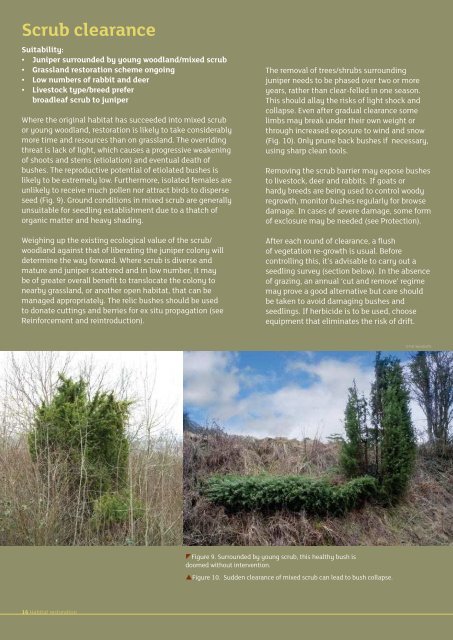Breaking new ground for juniper - Plantlife
Breaking new ground for juniper - Plantlife
Breaking new ground for juniper - Plantlife
- No tags were found...
Create successful ePaper yourself
Turn your PDF publications into a flip-book with our unique Google optimized e-Paper software.
Scrub clearanceBare <strong>ground</strong> creationSuitability:• Juniper surrounded by young woodland/mixed scrub• Grassland restoration scheme ongoing• Low numbers of rabbit and deer• Livestock type/breed preferbroadleaf scrub to <strong>juniper</strong>Where the original habitat has succeeded into mixed scrubor young woodland, restoration is likely to take considerablymore time and resources than on grassland. The overridingthreat is lack of light, which causes a progressive weakeningof shoots and stems (etiolation) and eventual death ofbushes. The reproductive potential of etiolated bushes islikely to be extremely low. Furthermore, isolated females areunlikely to receive much pollen nor attract birds to disperseseed (Fig. 9). Ground conditions in mixed scrub are generallyunsuitable <strong>for</strong> seedling establishment due to a thatch o<strong>for</strong>ganic matter and heavy shading.Weighing up the existing ecological value of the scrub/woodland against that of liberating the <strong>juniper</strong> colony willdetermine the way <strong>for</strong>ward. Where scrub is diverse andmature and <strong>juniper</strong> scattered and in low number, it maybe of greater overall benefit to translocate the colony tonearby grassland, or another open habitat, that can bemanaged appropriately. The relic bushes should be usedto donate cuttings and berries <strong>for</strong> ex situ propagation (seeRein<strong>for</strong>cement and reintroduction).The removal of trees/shrubs surrounding<strong>juniper</strong> needs to be phased over two or moreyears, rather than clear-felled in one season.This should allay the risks of light shock andcollapse. Even after gradual clearance somelimbs may break under their own weight orthrough increased exposure to wind and snow(Fig. 10). Only prune back bushes if necessary,using sharp clean tools.Removing the scrub barrier may expose bushesto livestock, deer and rabbits. If goats orhardy breeds are being used to control woodyregrowth, monitor bushes regularly <strong>for</strong> browsedamage. In cases of severe damage, some <strong>for</strong>mof exclosure may be needed (see Protection).After each round of clearance, a flushof vegetation re-growth is usual. Be<strong>for</strong>econtrolling this, it’s advisable to carry out aseedling survey (section below). In the absenceof grazing, an annual ‘cut and remove’ regimemay prove a good alternative but care shouldbe taken to avoid damaging bushes andseedlings. If herbicide is to be used, chooseequipment that eliminates the risk of drift.Controlled grazingSuitability:• Enclosed cattle-grazed grassland• Cattle breeds that rarely browse• Medium to large stands of male and femalebushes• Low numbers of rabbit and deer• Seed viability moderate-very good (>10%)High impact cattle-grazing during the ‘berry drop’ periodof Oct-Dec should create ideal conditions <strong>for</strong> naturalregeneration through poaching (>10% bare <strong>ground</strong>cover) – Fig. 11. Afterwards the site should be allowed torecover and extensively grazed as appropriate. Seedlingsurveys should take place annually <strong>for</strong> the next fewyears (see section below). Provided the sward will sustainno permanent damage, the regime may be repeated ifno seedlings appear.Some damage to adult bushes (e.g. broken branches)may be unavoidable. If young bushes or seedlings arepresent and cannot be protected (see Grazing exclosures)use another technique to create bare <strong>ground</strong>.Pinch-pointsFigure 11. Controlled grazing can produce copious germinationmicrositesFigure 12. Gateway pinch point© Pat WoodruffeSuitability:• Cattle-grazed grassland• Cattle breeds that rarely browse• Small distinct stands of male and female bushes,or satellite females• Low numbers of rabbit and deer• Seed viability moderate-very good (>10%)Figure 13. Poaching of <strong>ground</strong> around water troughPinch-points are narrow gaps through which livestockroutinely pass, creating patches of disturbed <strong>ground</strong>.They can result from natural obstructions (e.g. scrub) butare more commonly associated with gateways (Fig.12).At some sites, it may be possible to create pinch-pointsin the vicinity of berry-clad females using fencing,or through the strategic placement of water troughs(Fig.13). Although places where animals congregateor lay up tend to become nutrient enriched and havehigher browsing pressure, the routes to these places mayprovide ideal habitat.there will be a gradient of disturbance either sidethat may provide suitable microsites <strong>for</strong> germinationand growth.Figure 9. Surrounded by young scrub, this healthy bush isdoomed without intervention.Figure 10. Sudden clearance of mixed scrub can lead to bush collapse.Poaching is more intense where tracks are sunken orbounded by banks, ditches or fences. Animals driven orridden along such tracks have relatively little time tobrowse adjacent vegetation - including <strong>juniper</strong>. Althoughtrampling may be too intense, and soil too compacted,<strong>for</strong> <strong>juniper</strong> seedlings to establish in the track centre,Consideration should be given to reinstating routesthat have fallen into disuse such as old drove roadsand sunken ways, especially where old bushes survive.Opening up routes <strong>for</strong> public recreation (e.g. asbridleways or mountain bike trails) may offera good alternative.16 Habitat restoration<strong>Breaking</strong> <strong>new</strong> <strong>ground</strong> <strong>for</strong> lowland <strong>juniper</strong> 17
















